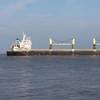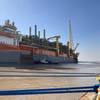The 240-ft. HOS Dominator built by LEEVAC Shipyards, Jennings, La; and delivered earlier this year to Hornbeck Offshore Services is a prime example of a vessel using a touch screen monitoring, sensing and alarm system. This vessel also has a GMDSS communications suite and is equipped with DP-2 dynamic positioning system. (Photo courtesy of Hornbeck Offshore Services)
By Larry Pearson
As noted in the accompanying article, alarm monitoring, tank level sensing and the control of almost every function onboard a vessel has made giant strides in just the last few years. Instead of banks of warning lights, vessel operators now use touch screen computer displays that intuitively troubleshoots a problem leading to a quicker resolution.
Frank L. Beier Radio, Harvey, La. has been on the cutting edge of the development and installation of many of these systems.
These systems have become standard equipment on a series of 240-ft. and 260-ft. supply vessels built by Hornbeck Offshore Services, Mandeville, La.
These monitoring and alarm systems have been integrated with Beier's IVCS-2000 dynamic positioning system onboard the Hornbeck vessels. The DP system onboard these giant supply boats is rated at DP-2 by ABS. The vessels also have an ABS-approved GMDSS communications suite also installed by Beier.
Bollinger Shipyards, Lockport, La. has chosen also chosen fully integrated touch screen monitoring and alarm system by Beier for their new state-of-the-art 207-ft. long supply boats. Bollinger is building a series of these vessels for Tidewater Marine, Seacor Marine, MNM Boats and are close to signing contracts with other offshore operators. The first of these vessels for MNM Boats will be delivered later this year.
"Monitoring systems are very much of an owners call," said Karl Beier, president of Beier Radio.
"Some owners think engine cylinder head temperatures are critically important, while others may want sophisticated monitoring of engine RPM or some other parameter," Beier added. The good news according to Beier is that these systems can be tailored specifically to an owners needs.
Not only can alarms be investigated via the touch screen, but also activation of the many of the vessel's systems can be controlled from a touch screen. For example, from the Login Screen (screen #1), the operator can touch the bulk mud icon and instantly a screen appears that shows a diagram of the bulk mud system (screen #2). From this screen, the bulk mud compressors can be started, inlet and outlet valves on each of the mud tanks can be opened or closed and the bulk product can begin to flow from the vessel to the rig. Note at the bottom of each screen is an alarm history indicating past alarms.
Very sophisticated monitoring of engine performance in real time is possible with this system. For example, touching the port engine icon on the main panel takes the operator to the icon of the port engine. From there another touch will bring up a real time display of the temperature of each cylinder head (screen #3) indicating average high temperatures, average low temperatures as well as high and low acceptable deviations.
Other available screens include a side-by-side display of the two bow thrusters including both alarm points and performance criteria all shown in real time.
"The system can be as sophisticated as the owner demands with literally dozens of touch screens available monitoring hundreds of parameters," Beier said. Important too is the ability to control and monitor the flow of dry and liquid products from the vessel to the rig again all from the touch on a computer monitor.
Other features of these advanced systems include the ability for the system to be remotely monitored. Every screen, every parameter available to the onboard crew can be monitored on shore. "The owner simply goes on the internet, contacts our server and the information flows to his computer monitor," Beier explained. "This can be a big assist for the crew that may be tied up with ship handling operations or delivering cargo or other materials to the rig," Beier added.
All the equipment used in the Beier system is ABS approved and available off-the-shelf literally anywhere in the world. "Some operators want to handle their own replacement parts and our system gives them that flexibility, "Beier noted.
While these new touch screen systems have a greater first cost than warning lights, such direct comparisions can be deceiving. Costs of wire and its installation is a big factor Beier believes.
"In a hard wired system, each monitoring location needs a complete set of wiring to that location, Beier said. "This system needs only a two wire pair to connect remote locations, not dozens or hundreds of wire and cables," Beier added. Weight of this wire and cable plus the labor to install it greatly reduces the price difference between these two systems. Also, the ability to quickly diagnose an alarm condition may save the premature replacement of a costly piece of equipment, Beier states. As these systems become more popular and therefore less costly, they may become standard on smaller vessels such as crew/supply boats and other workboats.
Subscribe for
Maritime Reporter E-News
Maritime Reporter E-News is the maritime industry's largest circulation and most authoritative ENews Service, delivered to your Email five times per week












